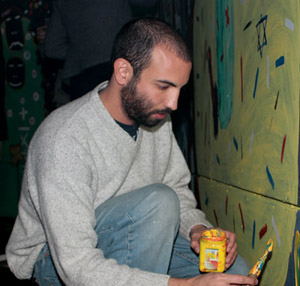The Line: a Pictography of Time
This exhibition was held on 7th August 2011. The exhibition took as its central theme the relationships between art and time.
For that occasion we invited five artists and a writer, each one with a different view about time and its relationship with the sacred. Gabriel Naude opened the event with a lecture on Henri Bergson and his views on time and art.
Matías Giovannini, besides from participating in the exhibition as a painter, held a conference on caligraphy: "From the gesture to the letter", in which he referred to caligraphy as an excess of devotion, of rehearsal, of time; an excess that a calligrapher may link to a ssacred functionality or not.
Nazareno López referred to his fascination with pop and religious icons and the transformation of the religious icons into pop icons and viceversa. The works he exhibited were portraits of Isabel "Coca" Sarli (an Argentinean actress who worked in several sexploitation films during the 1960's and 1970's) painted as a religious icon. Nazareo López explained that a pop icon may be suitable to absorb the inmanent time that the religious icons contain.
Juan Manuel Waimberg spoke of his art as search of the the instant and his intention of capturing a segment of the becoming.
Sebastián Tedesco discussed the double temporality that exists in several of his works where a "here and now" meets a mythical timelessness.
Ariel Tomaselli explained his work as a new approach to symbolism and a response to the temporal powers that try control our thought.
Ariel Tomaselli

"I perceive my work as a personal experiment that continues the poetic language that Carl Jung was investigating during the first decades of the XX Century.
This is why I felt the urge to translate my emotions into images: to continue his work and understand why Jung had given up translating his fantasies into an aesthetic language and focused on a scientific explanation. Jung holds that awareness does not establish exclusive relationships of reciprocity at the level of unconscious complexes, but is related to transpersonal constituents of the collective unconscious: the Archetypes."
Matías Giovannini

Through his work, Matías Giovannini communicates a seemingly paradoxical observation: that doubt is inherently both a defect and an effect of the rational mind, and the vitality of the stroke is accomplished through the work of mechanical repetition, trial and error, that internalizes the intent until it is able to appear from the unconscious movement of our muscles.
Juan Manuel Waimberg

Waimberg's work can be summed up in one word: Immediacy.
Short, fast series, exploring ideas and languages that are quickly completed and abandoned.
A constant and feverish search where results do not matter, but the capture of a fleeting immediate moment, but also the visceral involvement of whole body in the task.
A ritual of image building inspired by the creative process of children, trying to gain access to the deeper truths that only poetry can express.
Sebastian Tedesco

The ancient oracles spoke of the membrane that separates the material from the immaterial and gave it the name of Hecate, the dreamed Lady guarded by dogs. Beyond Her, they described an area with no duality, no heaven or earth, neither day or night; below, a tragic and blind world whose name is destiny.
Tedesco's art, just like the old oracles, can only exist at the border, the clandestine interzone between worlds where the smuggling takes place, a zone of jargon and cryptic whispers. On one side arcane archetypes not conceived yet; on the other, thousands of temporary representations. Between them, the wall, the fence and and the creational moment where heaven and earth are not yet divorced, intangible areas only crossed by the long hairs of the faceless Fates.
The border's palette of colors is gray-ocher, it's not exactly a color, but the knowledge of color still refusing to fade completely into the waters of Lethe. Contraband has a color, it is some gray-ocher tone, secretly placed between the material and immaterial world; it is used to refer both to oblivion and remembrance. Oracles and myths have given thousands of names to this archetype of every color, this predecessor; Da'ath, Sophia and Knowledge are some of the names they gave it; it is tone flowing in the paintings by Tedesco.
Nazareno López

The world Nazareno Lopez is a world of fantastic, mythical, monstrous beauties, heroes and figures with halos, in ecstasy just as if they were saints or martyrs.
Nazareno loves ambiguity, contradiction, and reflects it into his work as a mirror maze that decomposes it and returns it as a fragmented portrait in infinite versions, different faces of the same being.
His inspiration is nourished by the voluptuousness of eroticism, where the main protagonist is always the body, throbbing flesh portrayed in meticulous detail, the anatomy led to the idealization of the shapes.
This quest is actually an internal dialogue, a personal exorcism, a way to express the images of dreams that demand to be expressed.

















































































